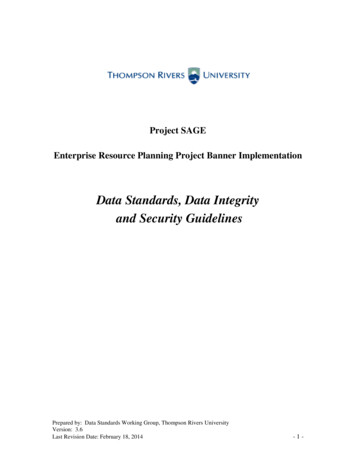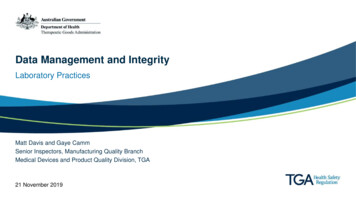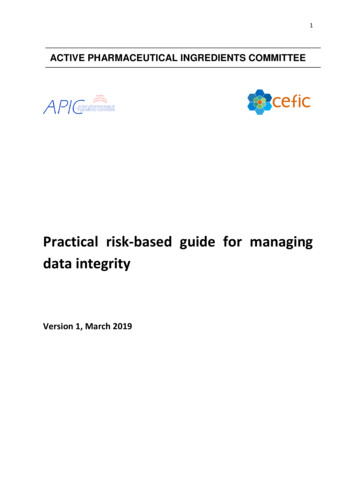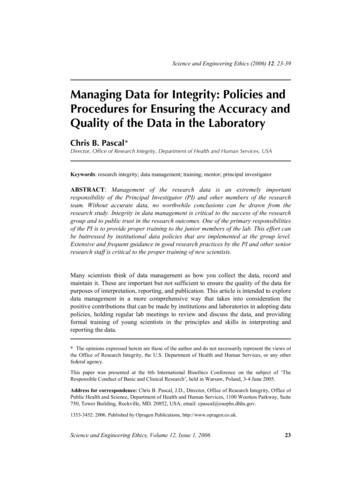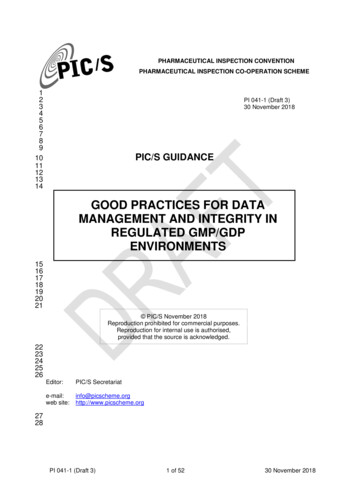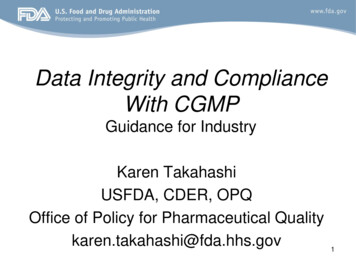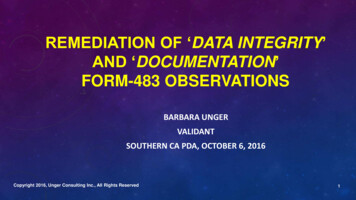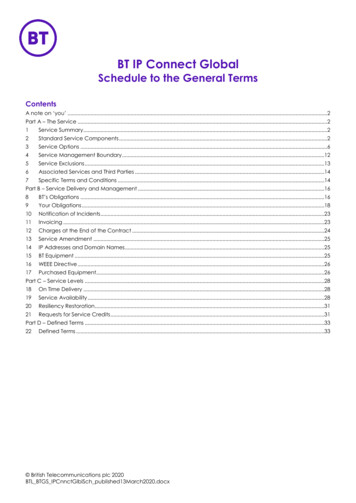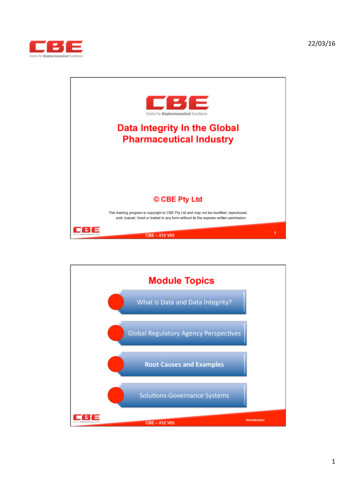
Transcription
22/03/16!Data Integrity In the GlobalPharmaceutical Industry CBE Pty LtdThis training program is copyright to CBE Pty Ltd and may not be modified, reproduced,sold, loaned, hired or traded in any form without its the express written permission.!1CBE – 012 V03Module gencyPerspecAvesRootCausesandExamplesSoluAons- ‐GovernanceSystems!CBE – 012 V03Introduc4on1
22/03/16!What do you think?Example occurring in same facility:1. Raw materials specifications set up by IT within MRP system“writes” to a word document in QC and printed out. (Nothingvalidated, not in QMS)2. QC uses specification and performs HPLC assay and othertests. No printouts from balances/ autotitrator, HPLC raw datadeleted after 1 month after Chromatograms printed out.3. All QC testing results calculations recorded on note paper,sticky notes and thrown away after a final “neat” report is typedin MS Word for release.4. All QC testing records are therefore “perfect”?!CBE – 012 V033Current Status Data integrity issues now regularly show up as criticalobservations in: FDA 483 Warning letters WHO “Notices of Concern” Based on Annex 2 Ch 17 EU Non-Compliance Reports FDA now Specifically targeting!CBE – 012 V0342
22/03/16!Who Does It Apply To?Extract from PDA Points to Consider Elements of a Code of Conduct for Data Integrity: Manufacturers of finished drug products for clinical trials, bioequivalence studies, andcommercial distribution Companies that conduct clinical trials in support of new drug applications including, butnot limited to: Investigational New Drug (IND), Clinical Trial Application (CTA),Investigational Medicinal Product Dossier (IMPD), Biologics License Application (BLA),Marketing Authorization Application (MAA), New Drug Application (NDA), andAbbreviated New Drug Application (ANDA) Laboratories that develop methods or formulations intended to support new drugapplications or laboratories that analyze samples generated from clinical trials Manufacturers of excipients, intermediates, or active pharmaceutical ingredients (APIs) Contract manufacturing organizations (CMOs) Contract research organizations (CROs) Contract testing laboratories Contractors, consultants, suppliers and vendors that provide services and data thatsupport the production and control of APIs, drug or biological products!CBE – 012 V035What is Data?The IT definition is that DATA are the RAW FACTs thatdescribe the characteristic of and event.Information is DATA converted into meaningful and usefulcontext.Wisdom (or fact based decision making ability) is what wehave then, when we have both.It follows that if you do not have the DATA how do youprove your decisions were not simply based upon opinionand not fact based drivers?!CBE – 012 V0363
22/03/16!Definition of Raw Data in Our Industry ?(FDA CFR 58 - GLPs) Raw data means any laboratory worksheets, records,memoranda, notes, or exact copies thereof, that are the resultof original observations and activities of a nonclinicallaboratory study and are necessary for the reconstruction andevaluation of the report of that study. In the event that exact transcripts of raw data have beenprepared (e.g., tapes which have been transcribed verbatim,dated, and verified accurate by signature), the exact copy orexact transcript may be substituted for the original source asraw data. Raw data may include photographs, microfilm or microfichecopies, computer printouts, magnetic media, includingdictated observations, and recorded data from automatedinstruments.!7CBE – 012 V03Information omebacktothisinthecontextofproblemareaslater .!CBE – 012 V0384
22/03/16!What is Data Integrity?MHRA Inspectorate Blog1 The extent to which all data are complete, consistent,and accurate throughout the data lifecycle*. From initial data generation and recording throughprocessing (including transformation or migration), use,retention, archiving, retrieval and destruction.(*Note the lifecycle approach is consistent with the principles of ICH Q10 PharmaceuticalQuality Systems)!9CBE – 012 V03Lifecycle lopmenttolaunchlifecycle- BE – 012 V03105
22/03/16!Global Regulatory ViewsCFR 211 indirectly addresses Data for example:1.2.3.Any Calculations must be verified 211.68(b)Methods must be documented and approved 211.160 (a)Data generated and transformed must meet criteria of scientific soundness 211.160(a)But more specifically under 211.194 Laboratory Controls(a)Laboratory records shall include complete data derived from all tests necessary to assure compliance with established specificationsand standards, including examinations and assays, as follows: (1) A description of the sample received for testing with identification of source (that is, location from where sample was obtained),quantity, lot number or other distinctive code, date sample was taken, and date sample was received for testing. (2) A statement of each method used in the testing of the sample. The statement shall indicate the location of data that establish that themethods used in the testing of the sample meet proper standards of accuracy and reliability as applied to the product tested .The suitability of all testing methods used shall be verified under actual conditions of use. (3) A statement of the weight or measure of sample used for each test, where appropriate. (4) A complete record of all data secured in the course of each test, including all graphs, charts, and spectra from laboratoryinstrumentation, properly identified to show the specific component, drug product container, closure, in-process material, or drug product,and lot tested. (5) A record of all calculations performed in connection with the test, including units of measure, conversion factors, and equivalencyfactors. (6) A statement of the results of tests and how the results compare with established standards of identity, strength, quality, and purity forthe component, drug product container, closure, in-process material, or drug product tested.ANDSOONANDSOON!CBE – 012 V0311WHOWHO Expert Committee on Specifications for PharmaceuticalPreparations Forty-eighth report:“15.9 Data (and records for storage) may be recorded by electronic dataprocessing systems or by photographic or other reliable means. Masterformulae and detailed SOPs relating to the system in use should beavailable and the accuracy of the records should be checked.If documentation is handled by electronic data-processing methods, onlyauthorized persons should be able to enter or modify data in the computersystem, and there should be a record of changes and deletions; accessshould be restricted by passwords or other means and the entry of criticaldata should be independently checked. Batch records stored electronicallyshould be protected by back-up transfer on magnetic tape, microfilm,electronic discs, paper printouts or other means. It is particularly importantthat, during the period of retention, the data are readily available.” Also mentioned in 15.1 and 17.3d!CBE – 012 V036
22/03/16!WHO NOC 2014 Summary 5 HPLC’s running with audit trail function in softwaredisabled. Although audit trail was enabled on some HPLC therewas no explanation or audit trail between actualintegration and manual method that was used for finalresult. On the same systems the time and date function hadbeen unlocked allowing for editing. All analysts within the same lab used a shared passwordtherefore no specific analyst in audit trail. Analysts could access and make change to files andHPLC run file where found in “recycle bin”.!CBE – 012 V0313Global Regulatory ViewsCFR 211 Part 11 Electronic Records and Signatures.PIC/S GUIDANCE PI 011-3 25 Sept 2007 Good Practicesfor Computerised Systems in Regulated “GXP”Environments.Both cover in detail the requirements for computerisedsystems- but this is not the topic of this presentation.A more important document is the FDA’s ComplianceProgram Guidance Manual 7346.832 NDA- Pre ApprovalInspections!CBE – 012 V03147
22/03/16!Global Regulatory ViewsCompliance Program Guidance CPG 7345.832 has specificdirective to FDA PAI inspectors regarding auditing of DataIntegrity:“There are three primary inspectional objectives of this PAIprogram, all of which require an informed strategy andcareful on-site evaluation. These objectives are:Objective 1: Readiness for Commercial ManufacturingObjective 2: Conformance to ApplicationObjective 3: “Data Integrity Audit”!CBE – 012 V03Global Regulatory ViewsObjective 3: Data Integrity Audit“Audit the raw data, hardcopy or electronic, to authenticate the data submittedin the CMC section of the application. Verify that all relevant data (e.g.,stability, biobatch data) were submitted in the CMC section such that CDERproduct reviewers can rely on the submitted data as complete and accurate.”“The inspection strategy may select key data sets or randomly select data .Generally, data on finished product stability, dissolution, content uniformity, andAPI impurity are good candidates for this audit.”“ During the inspection, compare raw data, hardcopy or electronic, such aschromatograms, spectrograms, laboratory analyst notebooks, and additionalinformation from the laboratory with summary data filed in the CMC section”“Raw data files should support a conclusion that the data/information ”!CBE – 012 V038
22/03/16!Global Regulatory ViewsObjective 3: Data Integrity Audit“Examples of a lack of contextual integrity include the failure by the applicant toscientifically justify non-submission of relevant data, such as aberrant test results orabsences in a submitted chromatographic sequence, suggesting that the applicationdoes not fully or accurately represent the components, process, and finishedproduct.”Remember DATA- INFORMATION WISDOM (decisions, justifications,rationales.)Inspectors are expected now to sit at the computer terminal and have you “replay”the raw data, and so basically if you no longer have the actual original raw datawhen an audit inspector says “SHOW ME” they will consider all decisions madedownstream are suspect and possibly fraudulent/fake.!CBE – 012 V03Root Causes1.2.3.4.5.6.7.8.IgnoranceLack of, or ineffectualtrainingBasic company ITignorance on data basemanagementOrganisational cultureAwareness of the risksHuman error/mistakesWilful falsificationManipulation postacquisition!CBE – 012 V039. Leadership (walk the talk)10. Lack of understanding ofinformation systems11. Actual hardware issues,data transmission.12. Software errors, lack ofchange control13. Obsolescence ofhardware/recording media14. Poor controls overdatabase managementsystems DBMS15. Technophobia of key staff189
22/03/16!Causation By CategoryPeople Inadvertenterrors Ignorance Workarounds LackofTraining TimePressure Culture Personality Resources OrganisaAonalfricAonIT/QA/QC m LackofPolicies LackofQMS NointernalAudit/Oversight DatabasemanipulaAonpracAces Cross- ‐funcAonalDBMaccountabiliAespoor ingHardware LackofCSV LackofITpolicies InadequateIQ Lackofsecurity,backup,authoriAes Lifecyclemanagement Obsolescence ITsystem“notuptothetask”19CBE – 012 V03Short Industry quisiAonsocwarewasnotvalidatedtoensurethere- rds”DWithintheQClaboratorytherewasevidenceofnon- orproducAon“managementinformaAononly”!CBE – 012 V032010
22/03/16!Short Industry inabusyQCenvironment- owaytore- E – 012 V03Key Expected Attributes-ALCOAAmributableLegibleContemporaneous hen? Signedanddated Thedatamustbelegible. Therecordshouldbepermanent. ofilm. CorrecAonsshouldbemadeinlinewithGDPsignedanddated. NoCompanyshorthand ewarethermoprinters) DatamustberecordedinrealAmeasandwhenitoccurred. stbeaccordingtowrimenprocedure. eesecondpoint).!CBE – 012 V03Original uirements. �caAon. Therecordsshouldnothavebeentamperedwith.Accurate Datamustcorrectlyreflecttheactualmea
(3) A statement of the weight or measure of sample used for each test, where appropriate. (4) A complete record of all data secured in the course of each test, including all graphs, charts, and spectra from laboratory instrumentation, properly identified to show the specific component, drug product container, closure, in-process material, or drug product, and lot tested. (5) A record of all .
